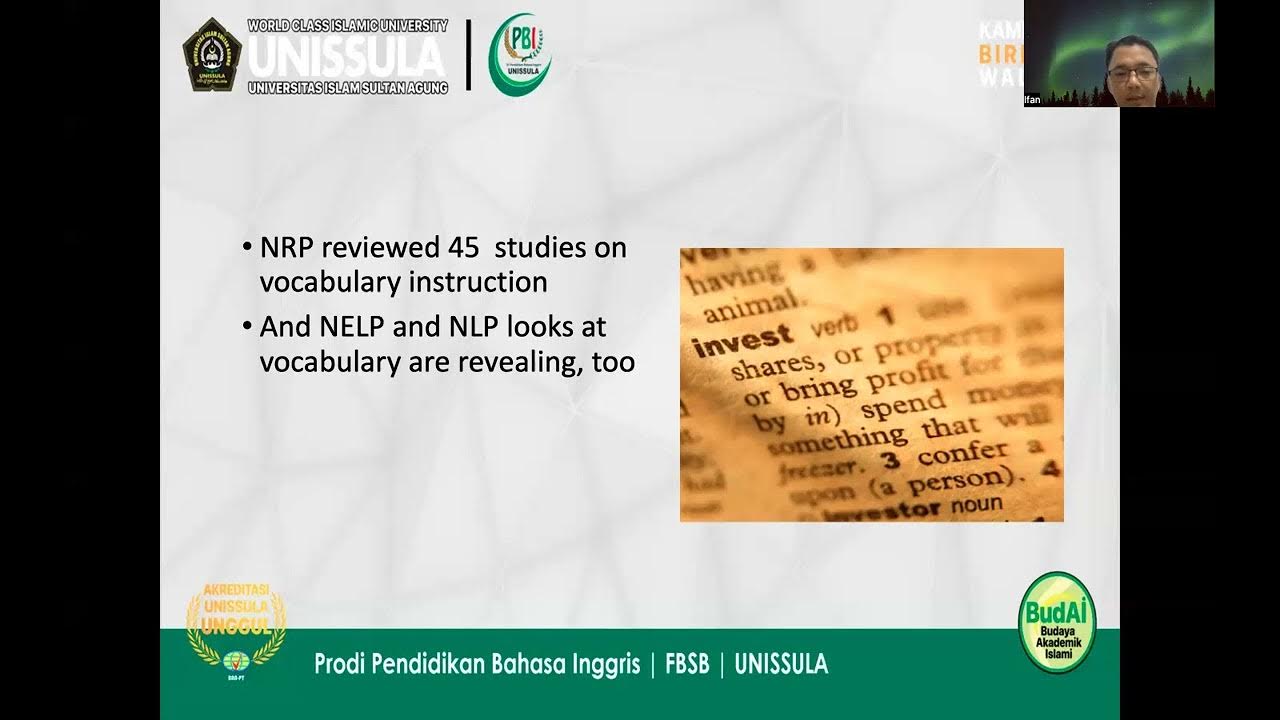Teaching Reading | Pre, While & Post
Summary
TLDRIn this video, the instructor outlines the key stages and objectives for teaching a reading comprehension lesson. The video focuses on three critical stages: pre-reading, while-reading, and post-reading. The pre-reading stage encourages students to survey the text and make predictions. During while-reading, students read the text and complete related tasks using reading strategies like scanning and skimming. The post-reading phase helps students connect the text to real-life experiences and engage in discussions or writing activities. The video offers practical guidance for both oral and written exam preparation in teaching reading comprehension.
Takeaways
- 😀 The main objectives of teaching reading are to help students understand the text and train them in reading skills like scanning and skimming.
- 😀 The pre-reading phase involves surveying the text, which includes looking at pictures, titles, subtitles, and keywords to get a general idea of the content.
- 😀 In the pre-reading stage, students can guess what the text is about by predicting questions or the main idea, and later check these guesses using reading skills.
- 😀 The 'while-reading' stage involves giving students time to read the text and then complete related tasks or exercises while applying reading skills.
- 😀 During the 'while-reading' phase, teachers should encourage students to use scanning and skimming skills while performing tasks.
- 😀 The post-reading phase focuses on connecting the content of the text to real-life situations, allowing students to compare, contrast, and reflect on the material.
- 😀 Students can discuss the text in pairs or groups during the post-reading phase, encouraging collaboration and deeper understanding.
- 😀 After reading, students can give their opinions on the topic or theme of the text, helping to further solidify their understanding.
- 😀 Teachers can ask students to write a paragraph to express their opinions or compare and contrast the content with their own experiences.
- 😀 The teaching of reading follows three stages: pre-reading (before reading), while-reading (during reading), and post-reading (after reading). Each stage serves a unique purpose in building reading comprehension.
Q & A
What are the two main objectives of teaching reading according to the script?
-The two main objectives of teaching reading are: 1) To ensure students read and understand the text and complete related tasks, and 2) To train students in reading skills such as scanning and skimming.
What is the first stage in teaching reading, and what activities are involved in this stage?
-The first stage in teaching reading is the 'pre-reading' stage. Activities include surveying the text by examining pictures, the title, subtitles, and keywords. Students can also guess questions the text might answer or get a general idea of the content before reading the text.
How do students check their guesses during the pre-reading phase?
-Students check their guesses by either scanning or skimming the text to see if their predictions are correct, such as verifying whether their guessed questions are answered in the text.
What activities do students engage in during the 'while reading' stage?
-During the 'while reading' stage, students read the text and then complete related tasks, exercises, or activities. They are encouraged to use reading skills like scanning and skimming while completing these tasks.
What is the key goal of the 'post-reading' phase?
-The key goal of the post-reading phase is for students to connect the content of the text to real-life situations, compare or contrast ideas in the text with their own experiences, and reflect on the subject matter.
How can students connect the text to real-life situations in the post-reading phase?
-Students can compare or contrast the information and ideas in the text with their own experiences, such as comparing how English is taught in their school versus the problems mentioned in the text.
What types of activities might be included in the post-reading phase?
-In the post-reading phase, students might be asked to discuss the content in pairs or groups, express opinions related to the text, or write a paragraph giving their opinions or comparing and contrasting the text with real life.
What reading skills are specifically emphasized in the script?
-The script specifically emphasizes reading skills like scanning (quickly searching for specific information) and skimming (getting the general idea of the text).
Why is the pre-reading phase important in teaching reading?
-The pre-reading phase is important because it helps activate students' prior knowledge, prepare them to understand the text, and guide them in making predictions about the content before they actually read it.
How can teachers encourage students to use reading skills during the 'while reading' phase?
-Teachers can encourage students to use reading skills by providing guidance during task correction, highlighting how techniques like scanning and skimming can be applied to answer questions or understand the text better.
Outlines

This section is available to paid users only. Please upgrade to access this part.
Upgrade NowMindmap

This section is available to paid users only. Please upgrade to access this part.
Upgrade NowKeywords

This section is available to paid users only. Please upgrade to access this part.
Upgrade NowHighlights

This section is available to paid users only. Please upgrade to access this part.
Upgrade NowTranscripts

This section is available to paid users only. Please upgrade to access this part.
Upgrade Now5.0 / 5 (0 votes)





